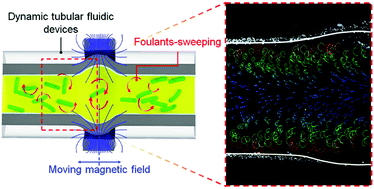Biofouling-resistant tubular fluidic devices with magneto-responsive dynamic walls†
Abstract
Biofouling of tubular fluidic devices limits the stability, accuracy, and long-term uses of lab-on-a-chip systems. Healthcare-associated infection by biofilm formations on body-indwelling and extracorporeal tubular medical devices is also a major cause of mortality and morbidity in patients. Although diverse antifouling techniques have been developed to prevent bacterial contamination of fluidic devices based on antimicrobial materials or nanoscale architectures, they still have limitations in biocompatibility, long-term activity, and durability. In this study, a new conceptual tubular fluidic device model that can effectively suppress bacterial contamination based on dynamic surface motions without using bactericidal materials or nanostructures is proposed. The fluidic device is composed of a magneto-responsive multilayered composite. The composite tube can generate dynamic surface deformation with controlled geometries along its inner wall in response to a remote magnetic field. The magnetic field-derived surface wave induces the generation of vortices near the inner wall surface of the tube, enabling sweeping of bacterial cells from the surface. As a result, the dynamic composite tube could effectively prevent biofilm formation for an extended time of 14 days without surface modification with chemical substances or nanostructures.



 Please wait while we load your content...
Please wait while we load your content...